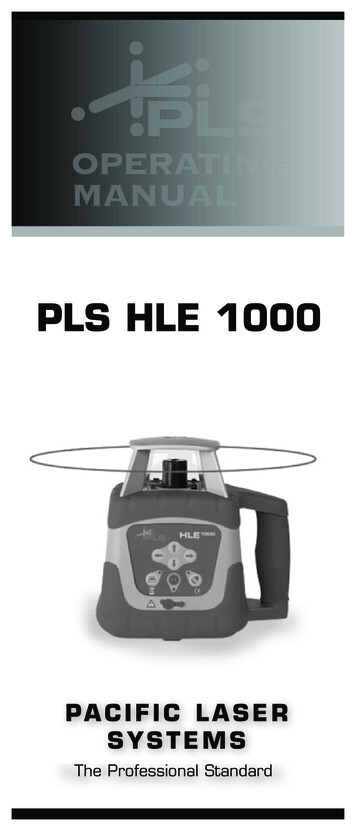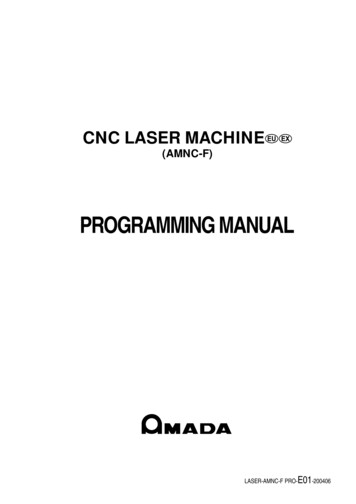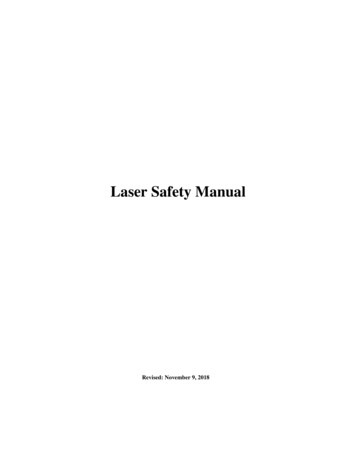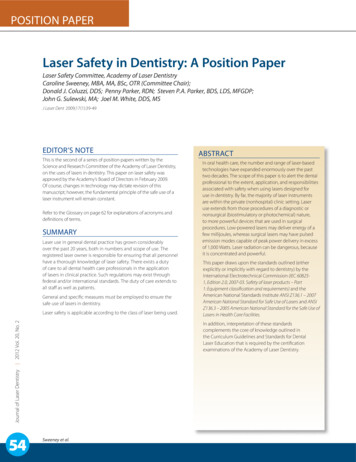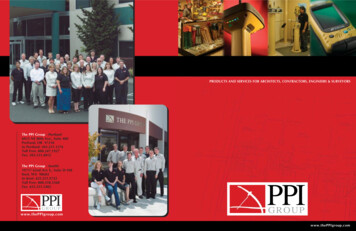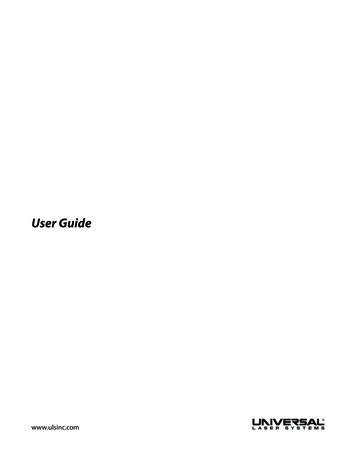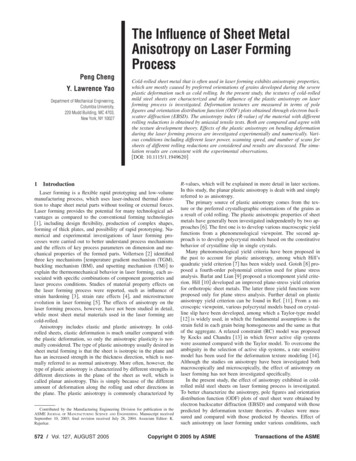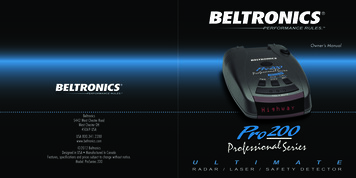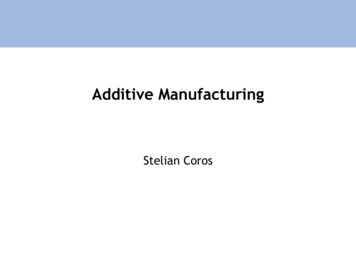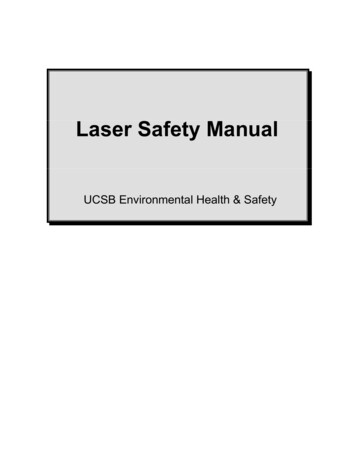
Transcription
Laser Safety ManualUCSB Environmental Health & Safety
Table of ContentsIntroduction. 1Manual Organization. 1Safety Precautions for Class 3 and 4 Lasers . 2Laser Inventory Form. 3Section 1: Laser Safety Program . 4Individual Laser Users . 4Principal Investigators. 4Laser Safety Committee. 5Laser Safety Officer (LSO). 5Environmental Health and Safety (EH&S) . 6Chancellor. 6Purchasing. 6Medical Surveillance. 6Section 2: Classification and Control. 7Hazard Classification. 7Class 1. 7Class 2. 7Class 3. 8Class 4. 8Laser Hazard Classes . 8Maximum Permissible Exposure. 9Table 5a. 10Table 5b. 11Table 6. 12Table 7. 13Nominal Hazard Zone. 14Nominal Hazard Zone Calculations . 15Laser Hazard Control Measures . 16Control Measures for the Laser Hazard Classes . 17Engineering Controls. 18Protective Housing. 18Interlocks on Protective Housing. 18Service Access Panel. 18Key Control. 18Viewing Portals . 18Collecting Optics. 18Totally Open and Limited Open Beam Path. 19Remote Interlock Connectors . 19Beam Stop or Attenuator. 19Activation Warning System. 19Emission Delay. 19Protective Windows . 19Administrative Controls. 20Laser Safety Procedures. 20Developmental Guidelines for a Laser Safety Procedure . 20Training. 23
Laser Safety Training for Operators and Others. 24Record of Laser Safety Instruction. 25Authorized Operating Personnel List . 26Alignment Procedures. 26Control of Spectators . 26Service Personnel Training. 26Indoor Laser Controlled Area. 26Warning Signs and Labels. 26Caution Sign. 28Danger Sign. 29Notice Sign . 30Personal Protective Equipment. 31Eye Protection. 31Skin Protection. 32Factors Common to Laser Accidents. 33Section 3: Non-Beam Hazards . 34Electrical. 34General Guidelines on Electrical Safety. 36Capacitors. 37Explosion. 37Fire. 37Optical Radiation (other than laser beam) . 37Ionizing Radiation. 38Gas Safety. 38Dyes and Solutions . 38Laser Dye/Solvent Control Classes. 39Precautions for Handling Dyes/Solvents. 41Additional Precautions for Dye Workwith Moderate (“M”) Controls. 42with Strict (“S”) Controls. 43Protective Glove Recommendation. 44Other Considerations. 44Appendices:Appendix AReferences . 45Appendix BSuppliers of Laser Safety Equipment and Services. 46Appendix CLaser Fundamentals and Bioeffects . 47Characteristics of Laser Light. 47The Lasing Process. 49Types of Lasers. 50Biological Effects of Lasers. 51Photosensitizing Agents. 53Appendix DGlossary to LASER Terms . 54
IntroductionUCSB Laser Safety ManualIntroductionThe Laser Safety Manual describes UCSB's laser safety program and provides guidance forthe safe use of lasers and laser systems. UCSB has adopted the elements of this program toassist researchers in conducting work with lasers as safely as possible while also meetingreasonable and legally defensible standards of precaution in the use of lasers. The programis intended to minimize record keeping, follow accepted good practices, and provideuseful resource materials for laser users. Comments on the program and manual contentare always welcome and may be addressed to either the Laser Safety Officer or the LaserSafety Committee. The information contained in this manual is based on the AmericanNational Standard for the Safe Use of Lasers, ANSI Z136.1-2000. Although the Z136.1standard is frequently cited in this manual, for more thorough guidance the completestandard should be reviewed.Manual OrganizationLaser users are strongly encouraged to purchase a copy of the ANSI Z136.1 standard(suppliers of the standard are listed in Appendix B).This Manual is divided into four sections (1) Laser Safety Program, (2) Classification andControl, (3) Non-Beam Hazards and (4) Appendices. Section One, Laser Safety Program, describes the program roles and responsibilitiesof the individual laser users, principal investigators, Laser Safety Committee, andcampus Administration. Section Two, Classification and Control, addresses laser safety based on theclassification scheme and required control measures of the Z136.1 standard. Section Three, Non-Beam Hazards, identifies the typical non-beam or ancillaryhazards of laser systems. The Appendices contains selected references, a list of suppliers of laser safetyservices and equipment, Laser Fundamentals and Bioeffects, and a glossary. LaserFundamentals and Bioeffects presents a basic review of the characteristics of laserlight, the lasing process, and describes major types of lasers. Also included isinformation on the biological effects of laser beam interaction with tissue, withemphasis on the eye and skin.A list of safety precautions for the use of Class 3 and 4 lasers is found on the next page.Following the safety precautions list is a flowchart, presenting an overview of the campuslaser safety program, and a laser inventory form. The inventory form is used by the LaserSafety Committee to track the quantity and type of lasers on campus, and allows the LaserSafety Officer to review and assist principal investigators in classifying lasers anddetermining the controls required for their operation. Each principal investigator whopossesses or acquires a laser must complete and return an inventory form to EH&S.1
IntroductionUCSB Laser Safety ManualSafety Precautions for Class 3 and 4 LasersClass 3 (eye and specular reflection hazard) Never aim the laser at a person’s eye or stare at the laser from within the beam. Keep the beam path above or below eye level for one seated or standing. Laser safety eyewear may be needed if MPE (Maximum Permissible Exposure) is exceeded. Don’t view beam directly with optical instruments unless a protective filter is used. Only experienced and authorized individuals are permitted to operate the laser. Secure the laser from operation by unauthorized personnel. A key switch should be used ifunauthorized personnel may gain access to the laser. Always strive to enclose as much of the beam path as practical and to operate the laser ina controlled access area. During alignment, avoid placing one’s eye near the axis of the beam path, where specularreflections are most likely to occur. Alignment eyewear should be considered. Unnecessary specular (i.e., mirror-like) reflecting objects should be removed from the beam path. Mount the laser on a firm support to ensure the beam travels along its intended path. Post laser hazard warning signs at entrances to laser use areas.Class 4 (fire, eye and skin hazard, diffuse reflection hazard) Review your laser safety procedure prior to laser operation. Strive to enclose as much of the beam as possible. A controlled access area is required. Entryway controls (e.g., warning lights, interlocks,protective eyewear, etc. ) are required. Assure that protective laser eyewear is available and worn by all personnel within the lasercontrolled area. If the beam is a serious fire and skin hazard, appropriate shielding should beused between the beam area and any personnel. Keep the beam path above or below eye level for one seated or standing. Use remote firing of the laser, video monitoring or remote viewing through a laser safety shieldwhenever feasible. If full laser power is not required, laser output filters and shutters which reduce the laser beamoutput to less than hazardous levels should be used. Assure that the laser has a key switch master control and that only authorized, properly trainedindividuals operate the laser. Mount the laser on a firm support to assure the beam travels along its intended path. Install appropriate laser warning signs at entrances to the laser controlled area. Keep in mind that optical pump systems may be hazardous to view and should be shielded.Optical pump systems for pulsed lasers can be spontaneously discharged, causing the laser tounexpectedly fire. Beam backstops should be diffusely reflecting, and composed of fire-resistant material.For more information, review the campus Laser Safety Manual, and the ANSI Z136.1 (2000) laser safetystandard of the American National Standards Institute.Phone Numbers:Emergency 9-911Laser Safety Officer, EH&S x3588Electrical Shop, Facilities Mgmt. x2997Gas Safety, EH&S x48992
IntroductionUCSB Laser Safety ManualLaser Inventory FormPrincipal Investigator Office Ph. #Department DatePlease complete for each laser (excluding laser printers, pointers, bar codereaders). Use additional sheets, if necessary.Laser ManufacturerModelWavelength(s): oµm onmWavelength(s): oµm onmWavelength(s): oµm onmWavelength(s): oµm onmWavelength(s): oµm onmWavelength(s): oµm onmHazard class of laser as indicatedby manufacturer: o1 o2a o2 o3ao4 oUnknowno3bLaser Location-Bldg:o3bLaser Location-Bldg:Serial NumberMax. Beam Power/Energy: omW omJMax. Beam Power/Energy: omW omJMax. Beam Power/Energy: omW omJMax. Beam Power/Energy: omW omJMax. Beam Power/Energy: omW omJMax. Beam Power/Energy: omW omJchanged?o3bHas laser been modified and the hazard classoYesoNooDon’t KnowLab. Ph.#:ModelWavelength(s): oµm onmWavelength(s): oµm onmWavelength(s): oµm onmWavelength(s): oµm onmWavelength(s): oµm onmWavelength(s): oµm onmHas laser been modified and the hazard classoYesoNooDon’t KnowLab. Ph.#:Room #:ManufacturerLaser Location-Bldg:changed?ModelWavelength(s): oµm onmWavelength(s): oµm onmWavelength(s): oµm onmWavelength(s): oµm onmWavelength(s): oµm onmWavelength(s): oµm onmHazard class of laser as indicatedby manufacturer: o1 o2a o2 o3ao4 oUnknownMax. Beam Power/Energy: omW omJMax. Beam Power/Energy: omW omJMax. Beam Power/Energy: omW omJMax. Beam Power/Energy: omW omJMax. Beam Power/Energy: omW omJMax. Beam Power/Energy: omW omJRoom #:Laser ManufacturerHazard class of laser as indicatedby manufacturer: o1 o2a o2 o3ao4 oUnknownSerial NumberSerial NumberMax. Beam Power/Energy: omW omJMax. Beam Power/Energy: omW omJMax. Beam Power/Energy: omW omJMax. Beam Power/Energy: omW omJMax. Beam Power/Energy: omW omJMax. Beam Power/Energy: omW omJchanged?Room #:Has laser been modified and the hazard classoYesoNooDon’t KnowLab. Ph.#:3
Section 1: Laser Safety ProgramUCSB Laser Safety ManualSection 1 : LASER SAFETY PROGRAMIndividual Laser UsersIndividual laser users must be aware of and responsible for: Attending laser safety training sessions as determined by the hazard classification ofthe laser they intend to operate (see “Training,” in Section 2, page 27). Reviewing, understanding and complying with the laser safety procedures prior tooperating their laser system. Wearing required protective equipment, such as approved eyewear and protectiveclothing. Maintaining engineering controls (e.g., interlocks not defeated) on the laser systemas designed, specified and approved by the laser manufacturer, or the principalinvestigator, in consultation with the LSO. Assuring that safety features which arenot functioning properly are reported to the principal investigator. Promptly reporting the details of any accident involving a laser to the principalinvestigator.Principal InvestigatorsPrincipal investigators are responsible for assuring that the use of lasers under theirsupervision complies with Laser Safety Committee policy, as described in this manual.Specific responsibilities include: Notifying the Laser Safety Officer whenever the principal investigator acquires,fabricates, transfers a laser to a different laboratory, or changes the hazardclassification of a laser system. Notification can be accomplished by submitting acompleted laser inventory form to EH&S. Developing written laser safety procedures for Class 4 lasers and ensuring that laseroperations are carried out in accordance with those procedures. Laser safetyprocedures must be posted near the laser system or made readily available forreview. Ensuring that laser operators, prior to actually using lasers, are properly instructedand trained in laser safety and are familiar with the laser safety procedure for theirlaser system. Training must be documented for all employees. Visitors to areas orlaboratories in which lasers are used must also be informed of the hazards andcontrol measures associated with these systems.Shawwal 23, 14234
Section 1: Laser Safety ProgramUCSB Laser Safety Manual Ensuring that laser maintenance and repair work are performed by qualified, trainedindividuals and conducted in a safe manner. Promptly notifying the Laser Safety Officer and discontinuing operation of a laserwhen an accident related to laser use has occurred.Laser Safety Committee (LSC)The Laser Safety Committee (LSC) consists of faculty, staff and student members whofunction as a peer review committee and are selected from departments where lasers areused. The LSC is appointed by the Vice Chancellor, Administrative Services, and isresponsible for establishing and enforcing campus policies relating to laser safety. TheLaser Safety Committee serves as an advisor to the campus Administration on mattersrelevant to laser safety and is the ultimate reviewing and authorizing agent for the use oflasers on campus.Laser Safety Officer (LSO)The Laser Safety Officer is a member of the Laser Safety Committee, carries out thedirectives of the Committee and advises on the overall status of the laser safety program.Major responsibilities and duties of the Laser Safety Officer are: Providing knowledgeable consultation and evaluation of laser hazards, reviewingand approving the written laser safety plan for a particular laser system. Ensuring that the campus use of lasers is in conformance with Laser SafetyCommittee policy. Maintaining records related to the campus laser safety program. Typical recordsinclude the laser inventory, accident investigations, hazard analysis and laser safetytraining. Inspecting and auditing laser systems and operations. Classifying or verifying the classification of laser systems. Suspending, restricting or terminating the operation of a laser system if the LSOconsiders the laser's hazard controls inadequate. Investigating any real or suspected accident resulting from a laser operation, andinitiating appropriate corrective action.Shawwal 23, 14235
Section 1: Laser Safety ProgramUCSB Laser Safety ManualEnvironmental Health and Safety (EH&S)Environmental Health and Safety is responsible for: surveillance of laser operationsthrough the staffing of a campus Laser Safety Officer (LSO); providing consultation andlaser safety services in conformance with the policies set forth in this manual, governmentalregulations, and national laser safety standards. EH&S is authorized to inspect all areas ofcampus operations and activities.ChancellorThe Chancellor's Policy on Environmental Health and Safety (P-5400), supports themaintenance of a safe and healthy environment by requiring safe conduct of operations andactivities in compliance with applicable safety and health consensus standards, practicesand regulations.PurchasingPurchasing will notify the Laser Safety Officer, EH&S, of all laser purchase requests,excluding laser printers, bar code readers, laser pointers.Medical SurveillanceMedical surveillance needs of personnel working in a laser environment are the same as forother potential health hazards. Medical surveillance examinations may include assessmentof physical fitness to safely perform assigned duties, biological monitoring of exposure to aspecific agent, and early detection of biologic damage or effect.Medical surveillance is strongly recommended for laser operators of Class 3b, and Class 4laser systems. Laser operators should have, at a minimum, a baseline examination of thefollowing, as specified in ANSI Z136.1: Ocular historyVisual acuityMacular functionColor VisionOcular Fundus with an OphthalmoscopeSkinThe Student Health Services’ Eye Clinic, extension 3170, can perform ophthalmologicexams.Any individual with a known or suspected eye injury should be immediately referred to anophthalmologist. Individuals with skin injuries should be promptly seen by a physician.Shawwal 23, 14236
Section 2: Classification and ControlUCSB Laser Safety ManualSection 2: CLASSIFICATION AND CONTROLHazard ClassificationThe American National Standards Institute's Z136.1 standard establishes a classification forlasers according to their relative hazard and defines control measures for each class. Laserhazard classes are based on the ability of the primary laser beam to cause biological damageto the eye or skin during intended use. The classes are not based on the non-beam hazardsassociated with a laser system, although they can be significant. “Ancillary” or non-beamhazards are addressed in Section 3. In assessing the overall hazard related to laser operation,personnel and environmental related factors must be considered, such as level of safetytraining, and existence of non-laser operators in same laboratory.The Food and Drug Administration requires that manufacturers classify their laser products.An instrument label is affixed to the laser by the manufacturer which indicates the hazardclass. Once a laser or laser system is properly classified, there should be no need to performmeasurements or calculations of the laser beam power or beam characteristics. When the laserhazard class is unknown, or when the laser has been modified and the hazard class haschanged, the Laser Safety Officer must be contacted to evaluate and classify the laser system.The four laser hazard classes, along with their subdivisions, are:Class 1Class 1 lasers are considered safe based on current medical knowledge. This class includeslasers which cannot emit levels of optical radiation in excess of the exposure limit for the eye(i.e. Maximum Permissible Exposure) under any exposure condition inherent in the designand intended use of the laser. A Class 1 laser system may contain a more hazardous laserembedded in the enclosure, but no harmful levels of the laser radiation can escape the systemenclosure. For Class 1 lasers containing an embedded higher class of laser, the enclosure mustbe interlocked.Class 2All Class 2 lasers operate in the visible wavelength region (400-700 nm), are sub-divided intoClasses 2a and 2, and are considered low-power lasers operating at less than 1 milliWatt.Class 2a lasers are not intended for prolonged viewing of the beam, but under normaloperating conditions would not be hazardous if viewed directly (i.e. intrabeam viewing) forperiods not exceeding 1,000 seconds. Class 2 lasers are not considered hazardous formomentary viewing of the direct beam for up to 0.25 seconds (i.e., aversion response time).The aversion response, blinking of eye and turning away, will afford ample protection fromthe beam of all Class 2 lasers. However, a Class 2 laser beam could be hazardous if one wereto intentionally overcome the aversion response and stare directly into the beam for longerthan 0.25 seconds. As a comparison, conventional bright light sources are also considered7
Section 2: Classification and ControlUCSB Laser Safety Manualhazardous if one were to overcome the natural aversion response and directly stare into thelight for an extended period.Class 3A Class 3 laser system can emit any wavelength, but cannot produce a hazardous diffusereflection unless viewed for extended periods at close range or with collecting optics. Class 3is subdivided into Class 3a and Class 3b. Class 3a lasers would normally not present a hazardif viewed directly for momentary periods with the unaided eye (i.e., without collecting optics)and operate at 1 to 5 milliWatts for those emitting a continuous wave beam. Class 3b lasersoperate at 5 to 500 milliWatts for continuous wave. The beam from all Class 3 lasers are notconsidered a fire, skin, or a diffuse reflection hazard.Class 4Class 4 laser systems can emit any wavelength, exceed 500 milliWatts, and are considered afire, skin, and a diffuse reflection hazard. The most stringent control measures have beenestablished for these lasers.Laser Hazard ClassesApplies to Wavelength Ranges*Type of HazardClassUVVisibleNear IRFar IRDirect OcularDiffuse 2NoYesNoNoNoNo3aYesYesYesNoOnly after1000 secNoOnly after0.25 esYesOnly when laseroutput near 3blimit of 0.5 WattYesYes*Various ranges, in nanometers, are:Ultraviolet (100-400)Visible (400-700)Near Infrared (700-1400)Far Infrared (1400-106).8
Section 2: Classification and ControlUCSB Laser Safety ManualMaximum Permissible ExposureMaximum Permissible Exposure (MPE) levels have been established by ANSI Z136.1 forvarious laser wavelengths and exposure durations. The MPE is the level of laser radiation towhich a person may be exposed without hazardous effect or adverse biological changes in theeye or skin. In most cases it is unnecessary to make use of the MPE directly, if the laser hazardclass is known and appropriate controls for that hazard class are implemented. Since thedetermination of the MPE for various wavelengths and exposure situations can be quitecomplicated, the complete ANSI Z136.1 standard or the Laser Safety Officer should beconsulted for further information.It is good practice to maintain exposure levels as far below the MPE values as possible. Onereason is that exposure to levels at the MPE values may be uncomfortable to view or feelupon the skin. MPEs for the eye and skin, along with correction factors for certainwavelengths, are listed on Tables 5 (a,b
Use remote firing of the laser, video monitoring or remote viewing through a laser safety shield whenever feasible. If full laser power is not required, laser output filters and shutters which reduce the laser
